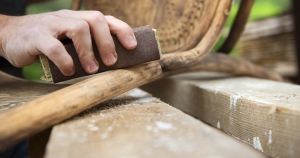Sanding is an activity people find themselves doing semi-frequently. Whether working on a design project, restoring a piece of furniture, or doing some basic repair, sandpaper can be your ally on numerous occasions. So let’s get a good understanding of it, and what you’ll need to know before you use it.
Sandpaper is made up of sharp edges designed to cut away at wood and metal. This is done by glueing these edges in various shapes onto a backing material with a bonding agent. The sharp edges can be made from any number of materials, and together are called the grit of the sandpaper. The amount of particles per square inch of sandpaper determines the grit size, which is how sandpaper is measured. This is good to know because the sandpaper you will choose will depend on how coarsely you want to sand. The heavier and more thorough the job, the smaller the grit. The larger the grit, the finer the result. Sandpaper will fall between 40 and 600 grit, giving a wide array of options to pick the best one for your job.
Garnet, emery, aluminum oxide, and silicon carbide are four commonly used particles that makeup the grit. Garnet is standard for general wood sanding. Emery is of good use for abrading or polishing metal. Aluminum oxide is a good option for contoured surfaces, or smoothing flat surfaces. Silicon carbide is among the coarsest, making it a good option for stripping or cutting through hard materials, including finishes and paint.
If you are doing woodwork, carpentry, or stripping a surface that is not fragile, a low, heavy grit will do the job. Prep work can be different, however. If you are preparing to prime and paint, your desired result will be a flat, smooth surface. With drywalls, 120 or 150-grit sandpaper will do well, given you don’t apply too much pressure. When sanding drywall, also remember to wear a dust mask, and reduce a breeze if possible, so the dust isn’t carried to settle throughout the house. If you’re preparing to repaint a room, rather than stripping the paint completely, you may first choose a coarser sandpaper to remove the bumps, and then a very fine one to smooth over once it’s complete, even up to 600-grit.
Most jobs that require a finish will benefit from, if not need, to be sanded. Choosing the right paper will allow you to get the best results, even if it means putting in longer work. The coarser the sand, the quicker the job. However, coarse sands can cause scratches that will show up later on. When in doubt, follow up a strong job with a fine sandpaper to finish, up to 220-grit. It’s important not to get impatient, because finish will amplify any scratches that may not have been noticeable on the bare surface. If you have a specialty job, double check with a professional in that industry for recommendations on the correct sandpaper to use, as you don’t want to damage the piece you’d like to refinish.

No comments:
Post a Comment